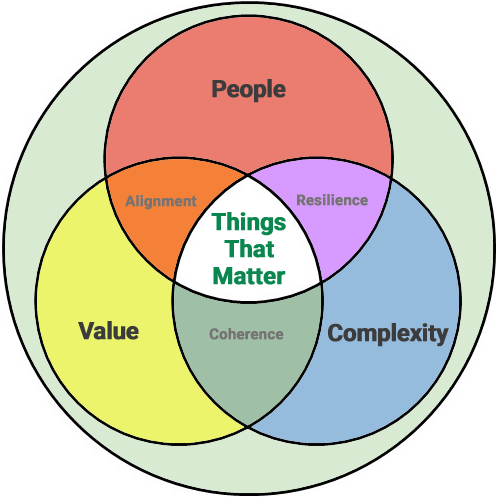Value Management: Why It’s Needed; Why It Works
Most of us are only all too aware of the overwhelming turbulence and challenges of today’s commercial environment.
Change is accelerating. There are more frequent and profound “shocks”. Global issues have increasingly local effects. Disruption abounds.
We don’t have to look far to see the overall results, as the Expectations Curve below shows: struggling relationships, waste, missed targets, and evaporating morale at every level – for individuals; for organisations; for entire industry sectors and Ecosystems:

What Is Going Wrong
Whilst few recognize it (and even fewer know what to do about it), Complexity is the root cause and it explains the most common “symptoms” people are experiencing, e.g.:
More Required With Less
There is an increasing need to do more and more with less and less – less money, fewer resources and less time – leading to overload, stress and a sense of being overwhelmed. Operational overload overtakes strategic value.
Rate of Change
One of the most commonly-experienced impacts of Complexity, the pace of change is accelerating, with decisions typically pressured and rushed, and a sense that they will very often turn out to be “wrong” and end up being criticized.
Short-term Dominates
In the increasing sense of chaos and difficulty, short-term considerations usually dominate. With resources stretched (especially time), it is even harder to manage the trade-offs between short- and long-term objectives, and focusing on the latter can seem like a “luxury” to consider, such that the bigger picture is often lost sight of.
Information Overload
The volume of information is constantly increasing – especially in an attempt to try and understand what is happening and anticipate what might happen next – and it is more and more difficult to gain clarity over what is really going on.
More Stakeholders and Wider Scope
Scope continues to grow into new areas (e.g. social value, ESG, DEI), due to there being ever more interconnected stakeholders to consider and satisfy, who often have overlapping and competing priorities.
Missed Targets and Blame
Implementation, financial and performance targets are often unrealistic and inflexible – sometimes even contradictory – which contributes to subsequent pressure, the targets often not being met and blame ensuing.
(All of these symptoms – and many more – feature in our Symptoms Of What’s Not Working Diagnostic, which helps pinpoint the impact of all this in particular situations.)
What Is(n’t) Being Done In Response
In response, some organizations do nothing:
- Either resigned to the situation: it’s just how it is, and they have to soldier-on as best they can.
- Or in denial, assuming that recent challenges (Ukraine, inflation, Covid, etc) are exceptional circumstances, and that things will return to normal soon.
But most organizations know that even “normal” is increasingly challenging and do recognize that something needs to be done.
The problem is that they then default to failed conventional management approaches, and these lead to more “symptoms” (which also feature in our Symptoms Of What’s Not Working Diagnostic), e.g.:
Disconnected Strategy & Operations
Strategy, plans and contract documents are mostly static and infrequently referred-to: they are often out of touch, frequently out of date, and unable to adequately guide or respond to what’s happening on the ground.
Contracts vs Relationships
Staff are increasingly caught in the conflict between (i) being expected to administer and enforce legal aspects of contracts, and (ii) to practise relationship management and deepen relationships to achieve commercial outcomes.
Lack Of Empowerment
Rigid structures of roles and responsibilities lead to a lack of delegation and empowerment, preventing pragmatism, agility, flexibility and the leverage of discernment and expertise.
Change Not Embedded
Attempted change initiatives rarely have much obvious, measurable or lasting impact (despite increasing consultancy costs, time spent in workshops, behavioral training, attendance at industry events, etc).
Lost Faith in Leadership
High/increasing levels of distrust in leadership, who are seen as out of touch, not listening, making bad decisions and mostly/only pursuing their own agendas and disconnected high-level abstractions.
Words and Actions Inconsistent
There is inconsistency between the stated behaviors and goals, and what actually happens, what gets incentivized, and what gets measured at the front line.
There are lots of reasons organizations default back to familiar failed approaches, and a major one is that there hasn’t been an alternative.
But now there is: Value Management.
Value Management: The Way Forward
Unlike failed conventional approaches, Value Management succeeds because it is:

- Complexity-Aware: understanding and incorporating the dynamics of Complexity – and, in particular, how technology fuels them – such that it can be harnessed. This then means being…
- People-centred: empowering People (who are the fundamental “root” of Complexity and the source of creative responses to it), fostering discernment, and achieving engagement, motivation and change. This then means being…
- Value-led: understanding Value in its widest sense as the driver of engagement, motivation and change, and using it to shape all decision-making and activity – optimizing effectiveness and maximizing benefits.
Value Management is therefore the only appropriate and effective approach that can be embedded, spread and scaled, meaning that organizations don’t just survive today’s challenges, but instead thrive.

Featured content:
Our series about Complexity going unrecognized and not responded to appropriately:
- Introduction
- Part 1: Grenfell
- Part 2: Crossrail
- Part 3: HS2
- Part 4: London Terror Attacks
- Part 5: Boeing 737
(Now added to with further Boeing 737 issues)
Our series on how Tesla embody Value Management:
